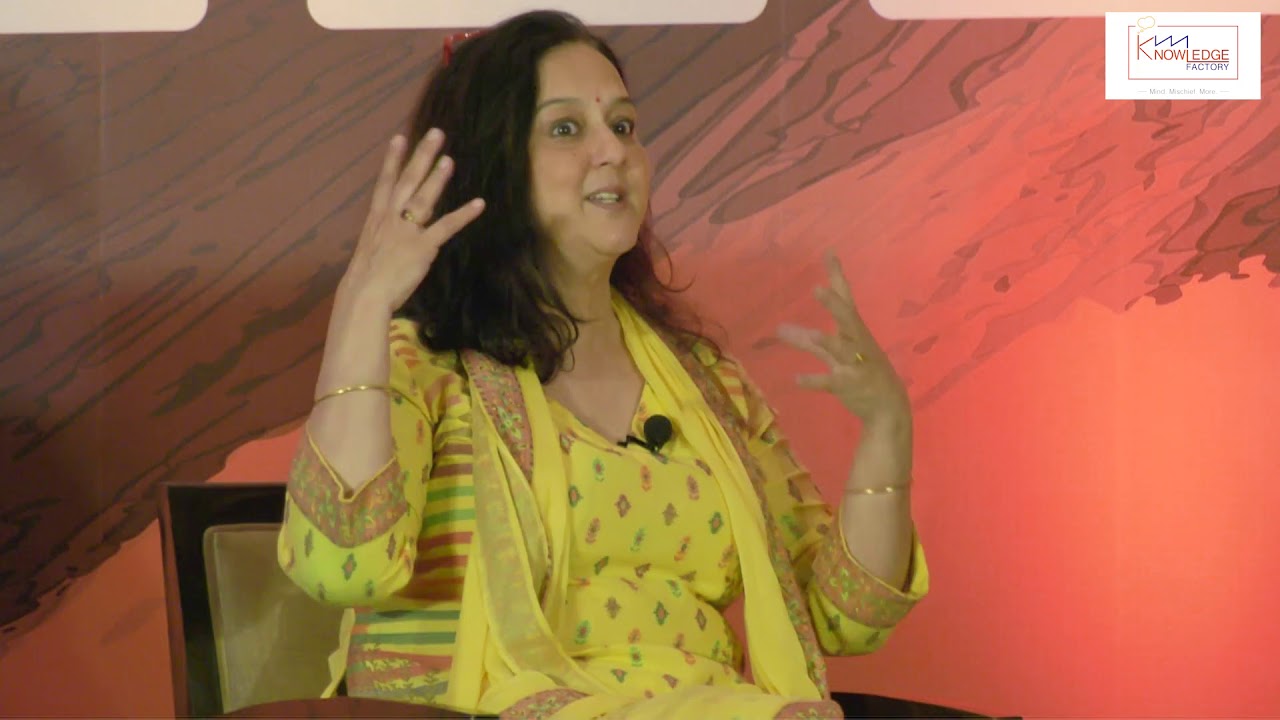Our Cities, Our Rivers: Re-imagining the Relationship

As 1.3 billion people seek better lives in a monsoon-dependent economy, the white and green revolutions may have produced grains and milk, but water is in some parts of India today more expensive and less accessible than milk. Ground water resources are depleting. NIITI Ayog sees a crisis by 2020. Where do we stand? How can water sharing disputes like the Cauvery problem be really overcome? Where can we go from here? How can communities, technologies or business models solve the problem or not? How can corporate, policymakers, NGOs and individuals contribute constructively.
This is an edited version of Rohini Nilekani’s conversation with Dr. Mihir Shah at Knowledge Factory, 2019 held in Bangalore.
As 1.3 billion people seek better lives in a monsoon-dependent economy, the white and green revolutions may have produced grains and milk. But in some parts of India today, water is more expensive and less accessible than milk. Ground water resources are depleting, and NITI Ayog sees a crisis by 2020. So how do communities, policymakers, and corporates create constructive solutions to this problem?
The Relationship Between Rivers and Cities
When we talk about reforming policy or making a change which would actually impact people positively on the ground, there are a couple of things to keep in mind, which Dr. Shah, with his experience on the planning commission and his work in Samaj Pragati Sahayog, puts it succinctly. The first is to be in a position to reform government systems and processes, because we cannot solve problems like water without involving the government.
While drafting the Twelfth Five Year Plan for India’s water policy, Dr. Shah created a working group of experts from outside the government, despite resistance from the Prime Minister’s Office. He brought in experts like Tushar Shah and Sunita Narayan to influence policy which was focused on arriving at a common ground on water. Everyone was forced to put their fundamentalisms outside to arrive at this common ground and make compromises. However, they were able to sign off on a document that represented a paradigm shift in how water will be managed in this country.
This is one sort of model if we are to re-imagine the relationship of rivers and our urban settlements, where we create working groups, bringing together elements of the continuum of Samaaj, Bazaar, and Sarkaar. You cannot solve complex societal issues without reducing the friction to collaborate between Samaaj, Bazaar, and Sarkaar, and this example shows us the way forward. We know that the Bazaar has a lot of innovation, including technological innovations to offer the water sector and I think we’ve not deployed enough of those. From Samaaj side, sometimes there has been a resistance to using technologies but I think the time has come when we seriously need to look at many new technologies which need the Bazaar’s active involvement to put them out into the world, with policy support from the state.
With these working groups that were set up under the Planning Commission, there was a paradigm shift in water management governance as well. As Dr. Shah points out, we applaud higher rates of growth, but do not realize that these cannot be sustained unless we also take care of the larger ecosystem, the ecology that is sustaining this process of economic growth.
For example, if we look at the relationship between cities and rivers, there is an engineering cliché, that rivers which flow into the sea are a waste and they should be dammed to bring water to the cities around it. But if we remember the lessons on the hydrological cycle that we learnt at school, we would know that it doesn’t make any sense not to allow rivers to flow into the sea. Many of our rivers today are not reaching the sea and that’s going to have serious consequences on the hydrological cycle and the monsoon patterns over time. To say that we are wasting water when we let it go into the ocean is ignoring very basic science that we learnt in third grade.
Instead we are redirecting rivers to our cities, encroaching on the drainage lines which means encroaching on the channels through which these rivers are flowing themselves. If the water is not allowed to flow through its natural course, when heavy rainfall or climate change events arise, we then face problems of urban flooding. Life and livelihood on the subcontinent could be deeply threatened. So if we don’t understand ecology and how to sustain our rivers, then we are already dooming ourselves, and our cities.
A Problem of Imagination
The situation in Bangalore is particularly interesting because we bring water from the Kaveri at great expense and at a great energy cost. We actually pump up the water from a great distance, but so many of us in the city take the Kaveri for granted. We don’t think about who is being deprived of that water by this relocation, and instead we use it, pollute it, fail to treat it, and then we send it off, creating a lot of negative downstream impact because of that.
ATREE, an organization that I support, has been doing a lot of work on the Vrishabhavathi and the Arkavati – two rivers that were tributaries of Kaveri, that were flowing through our city. Vrishabhavathi originates from the bull-temple itself, and the Dakshina Pinakini is not far from the city, originating in the Nandi Hills. There are a lot of people trying to understand how we can revive these rivers and drive back the Kaveri because Bangalore does have enough rain and lakes, and we would also have rivers if we are able to rejuvenate them. We really don’t need to bring Kaveri water to feed this thirsty city. But as of now, the Vrishabhavathi is nothing but a drain. The imagination of citizens with their rivers is destroyed, so we have no relationship with the idea of a river anymore. Nobody remembers a healthy flowing river in this city anymore, which is a real pity. But imagine if we could bring back these three rivers, the Dakshina Pinakini, the Vrishabhavathi and the Arkavati – that would mean so much.
Some of the research that was conducted at ATREE showed that one of the reasons why the Arkavati is not flowing anymore is because there has been so much groundwater pumping in an unrestricted fashion, which is affecting the base flow of rivers. In India, we have an un-channelled groundwater regime, and so our river flows are getting seriously affected because people are sucking groundwater from anywhere, without any regulation. Usually, after the monsoon, these rivers gain water from the groundwater basin. However, since groundwater has been extracted, deeper and deeper, the water now flows from the river into the ground, which results in them losing water and eventually drying up.
As Dr. Shah notes, we need policy changes as well as a people’s movement to protect our water. This work cannot be achieved by the government alone, citizens also need to understand the management of groundwater. As of now, the government has initiated the Atal Bhujal Yojana as part of the Twelfth Five Year Plan, with six thousand crores (three given by the World Bank and three coming from India). However, along with cooperation from bureaucrats and hydrogeologists, we need the citizens, who are the primary stakeholders, to come together. The dissemination of this information to people who are actually using this groundwater will ensure that they use it sustainably. So it’s a complete relationship of interdependence between different forms of water and between nation and society. That interdependence has to be embodied in powerful partnerships for change. Without that, we will continue to make mistakes and the paradigm shift will not come.
So we need to focus on local solutions which are reviving lakes, roof-water harvesting, managing the groundwater more sustainably, and using waste water more creatively. Wastewater is another problem, as Dr. Shah mentions, because water quality is becoming a very serious issue in India. Unless we are able to recycle water and make it of the requisite quality, we are causing a great deal of ecological damage. Our cities only imagine treatment plants at the ends of its bounds, but actually they need to be throughout the city so that clean water is being returned to the storm water drains. We can see successful examples of this in Jakkur and small towns where, instead of making the same outmoded mistakes, we are able to bring in 21st century technologies to treat wastewater. So it’s a question of breaking down the pure engineering paradigm, understanding the power of decentralization, and keeping an interdisciplinary, ecology-based, landscape-oriented design.
We Need to Work Together
If we look at urban governance in India, we can see clearly that our current model of both our cities and rivers has not yet emerged . Even in a powerful place like Delhi, the Yamuna is nothing but a drain. It’s the most polluted stretch of river imaginable, which is surprising when you consider that there is no lack of money, and that our nation’s capital should be setting an example of how to look after our rivers. But unfortunately, we have not empowered our cities at all, in terms of how they are run, who elects the mayors, how long the mayors are empowered to do their job, or how they can raise financing to do intra-city projects. It’s these things that also allow citizens to be directly in contact with a responsive and accountable administration. I think Bangalore is also suffering for the same reasons, because we do not have the right governance institution for urban management.
Many countries in Europe show how a decentralized, accountable governance model actually has the capacity to raise capital for things like this. A lot of us take hope from the situation of the River Thames. In the ‘60s, it was a biologically dead river, but the city got its act together and today the River Thames in London is the cleanest river in Europe. There are 125 species of fish in it now, and we can see how rivers and biodiversity ecosystems are so inextricably linked. It’s a question of imagination as well. Can we imagine Bangalore with two rivers flowing, with clean, treated water feeding those rivers? I want to imagine our lakes being revived because we collectively did the work of reviving them. I think we should strive for that imagination.
When I went to Uttarakhand with Ravi Chopra of People Science Institute, we visited 16 river valleys, and it was heart-breaking to see how the dams were built back-to-back and to serve far away cities. Rivers that were so full of life became slowly choked as they reached Delhi. We need to realize that we cannot afford this. As Dr. Shah said, the economy rests on the base of the ecology and if we forget that connection, we’re not going to be able to have the sustainable growth that is necessary to lift the remaining 300 million people out of poverty in this country. We need to view water in a multi-disciplinary manner, in a cross-disciplinary manner and with multiple stakeholders all coming together, sitting across the table with mutual respect for each other.
So we need to create a citizen movement, to put pressure on our politicians. Without water, there is no life. Our urban economy suffers and we can already see that in parts of Bangalore where there is water scarcity. Some people think that the city will see mass relocation, if we are not able to manage our water properly, and we cannot afford to let that happen. We need to start thinking about re-engaging with our city’s water future, because that can make the difference between whether our cities are going to thrive or have to face a serious crisis.
